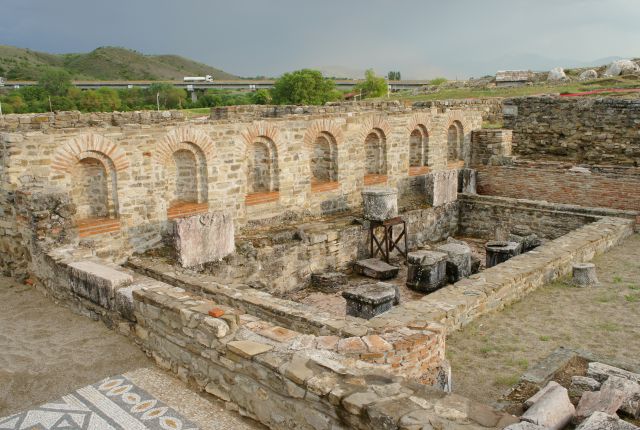Stobi
is the most famous archaeological site in the Republic of Macedonia. It is
located near town Gradsko in the Republic of Macedonia
Stobi was
an ancient town of Paeonia. It is located on the main road that leads from
the Danube to the Aegean Sea. Stobi was built where the Erigón
River (mod. Crna) joins the Axiós River (mod. Vardar). Because of its
location, Stobi was an important army, strategic, economic and cultural center
at the time. Later Stobi was conquered by Macedonians, and later turned
into the capital of the Roman province of Macedonia Salutaris.
Foundation
Stobi
developed from a Paeonian settlement established in the Archaic period.
Located on the northern side of a terrace, the early town covered an area of
about 25,000 m2 (270,000 sq ft). Its proximity to the
junction of the Erigón and Axiós Rivers as well as its position in the fertile
central Vardar valley allowed it quickly to develop a flourishing economy and
to establish trade. Nearby Mount Klepa was a lucrative source of
marble. The initial Paeonian population was later supplemented by other
immigrant groups.
The Macedonian period
It
is believed that in 217 BCE, Philip V annexed Paionia during his
campaign against the Dardani who had entered Bylazora, the
largest Paeonian town.
The city
was first mentioned in writing by the historian Livy, in connection with a
victory of Philip V of Macedon over the Dardans in 197 BC.
The Roman period
In
168 BC, the Romans defeated Perseus and Macedonia was
divided into four nominally independent republics. In 148 BC, the four provinces
of Macedonia were brought together in a unified Roman province.
During the
reign of Augustus the city grew in size and population. The city in
69 BC became a municipium and began to mint coins printed with Municipium
Stobensium. The citizens of Stobi enjoyed Ius Italicum and were
citizens of Rome. During Roman times Stobi was the capital of the Roman province
Macedonia Salutaris. Emperor Theodosius I stayed in Stobi in 388.
At
the time of the establishment of the Christianity, Stobi was quite influential
as the Archbishop's Seat and later as an Archbishopric. A lot of churches and
basilicas with rich interior decoration, luxurious private palaces and other
significant buildings come from this period. There was also a Jewish community
in Stobi in the 3rd Century. The Synagogue that proved this was torn down at
the end the 4th Century and a Christian basilica was built on its remains.
The destruction
Late
in the 5th century the city underwent a terrible turn of events. In 479, it was
robbed by Theodoric, an Ostrogothic king. The citizens
reconstructed the city, but in 518 it was struck by a powerful earthquake.
Avaro-Slavic invasions in the 6th century destroyed the city's economy and
infrastructure.
The
discovered coins from the second half of the 6th Century (from the Byzantine
emperor Justin II) and the necropolis with 23 Slavonic crests from the 9th to
the 12th Century confirm that there was life in Stobi after the earthquake. The
town was renovated, but never reached its previous level of prosperity.
Today,
the remains of this famous archaeological site are very popular tourist
destination in Republic of Macedonia.














